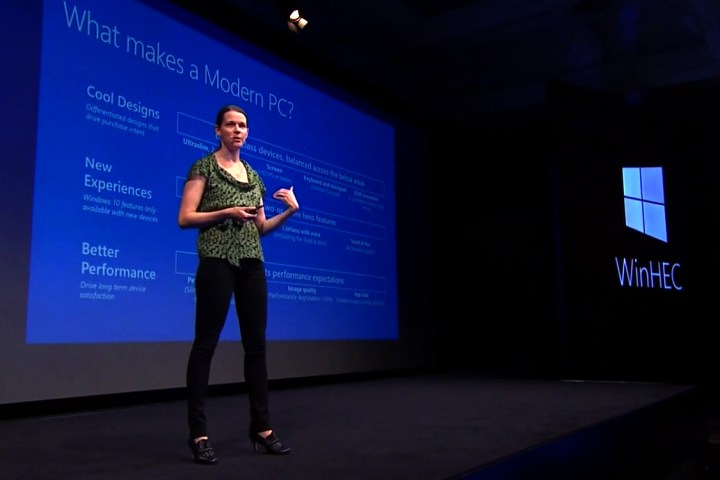
Microsoft defines “hero” as a major feature only offered with Windows 10. For instance, Windows Hello can be used with fingerprint scanners and face-recognition-capable cameras. There’s also Cortana, which enables users to search the web, set reminders, schedule appointments, and more using voice commands. Windows Ink is another “hero” feature, one that supports stylus-based input.
Microsoft discovered that devices are more attractive to buyers when they support features like facial recognition and pen-based input. But they also need to drive long-term consumer satisfaction. That means using great processors, batteries promising 10 hours of uptime or more, and fast boot times. The image quality needs to be superb, and apps should load almost immediately. Screens should be based on IPS panel technology and sport a default resolution of no less than 1,920 x 1,080.
Finally, Microsoft wants to see ultraslim, 2-in-1, and all-in-one (AIO) PCs starting at 8.82 inches thick. The mobile units should include a precision touchpad, while all new Windows 10 devices in 2017 should showcase innovations provided by manufacturers such as special hinges and borderless frames.
Microsoft expectations for 2017 can be broken down into five categories:
| PCs for the Modern Creator: | These devices should consist of 2-in-1 detachable or convertible form factors. They should include user-facing and world-facing cameras, and support Active Pen technology. They should also support simultaneous touch and pen inputs as well. ————— |
| Modern Peripherals for Everyone: | These devices should support Cortana, Windows Hello, and Windows Ink. The packaging will have specific labels so that consumers know the device is compatible with a specific Windows 10 hero feature. ————— |
| PCs to Power Mixed Reality: | Microsoft wants this batch of devices to push the form-factor envelope with creative 2-in-1 and backpack designs. OEMs need to think about using processors with multiple threads. Discrete GPUs will be supported initially, followed by integrated GPU support toward the 2017 holiday season. ————— |
| PCs for the Gamer & Media Fanatic: | These devices should include VR-ready graphics chips that support DirectX 12, and screens supporting High Dynamic Range and a wide color gamut. Devices should also support Xbox peripherals and feature a “standout” design to win customers over visually. ————— |
| IoT Devices for Verticals: | Microsoft will focus on smart manufacturing, smart retail, and smart homes in 2017. The company will roll out new features for these three verticals in Creators Update, set to arrive in the spring. |
It looks like 2017 will be an interesting year for Windows 10 and Microsoft’s customers. as interesting new form factors and peripherals hit the market. As the presentation revealed, these devices will support special Creators Update features, virtual reality, augmented reality, and the hero features provided in Windows 10.
Editors' Recommendations
- Windows 11 vs. Windows 10: finally time to upgrade?
- The best Windows 10 keyboard shortcuts
- Top 10 Windows shortcuts everyone should know
- Windows 11 might pull ahead of Windows 10 in one key way
- Microsoft adds message on unsupported PCs running Windows 11


